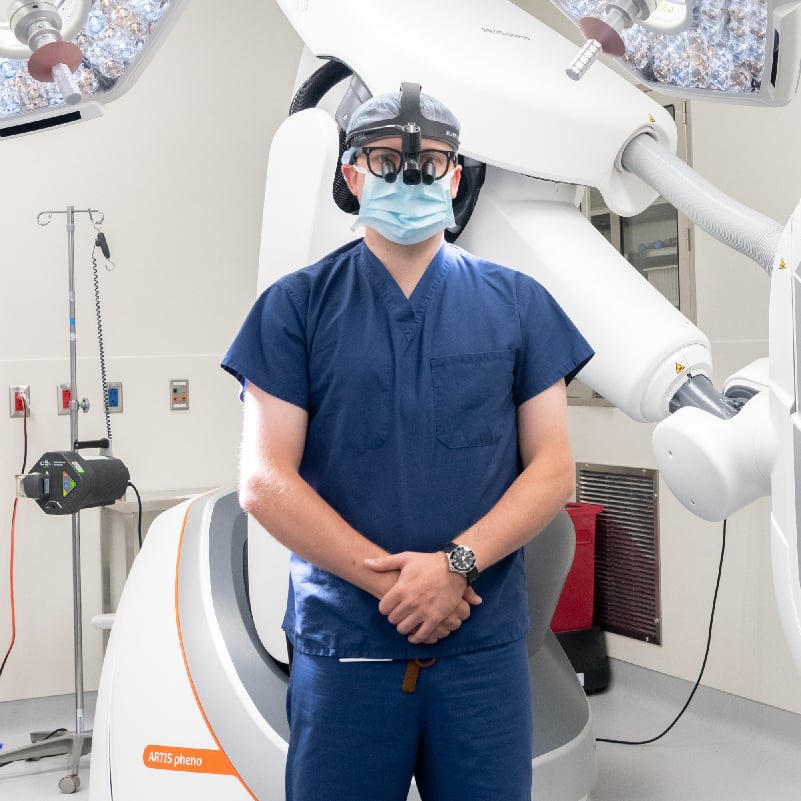Coronary artery disease is a common heart problem in the U.S. Once a person is diagnosed, the disease does not go away – but there are steps they can take to reduce their risk of worsening the health of their heart.
We asked Abdallah Bitar, MD, a cardiologist with Rochester Regional Health, to explain the disease, what puts a person at risk for it, and steps that can be taken to reduce those risks.
What is coronary artery disease?
Coronary artery disease (CAD) is a disease of the arteries that run around the heart, which wrap around the heart muscle.
Coronary arteries are like fuel lines to an engine; in this case the body’s engine is the heart. The coronary arteries (fuel lines) send blood (fuel) to the heart (engine) to keep the body running. The coronary arteries can narrow over time, much like crud can develop inside fuel lines. The coronary arteries can become narrowed with cholesterol-rich plaque or calcium. That narrowing is called atherosclerosis.
As less blood is able to get to the heart, the heart will begin to “sputter”. This will lead to common symptoms such as chest pain or shortness of breath, or less common symptoms such as jaw or arm pain.
Risk factors
These are characteristics or traits that someone is born with or are developed over time that can lead to a particular medical condition.
For CAD, risk factors can include:
- High blood pressure
- High cholesterol (genetic or acquired)
- Obesity
- Diabetes
- Smoking
People who have diabetes are at least twice as likely to develop CAD compared to someone who is not diabetic. Smoking is also a significant risk factor, almost on the same level as someone with diabetes.
Symptoms
Patients who may be suffering from undiagnosed CAD might experience:
- Chest pain (angina)
- Shortness of breath
- Jaw or arm pain
- Chest discomfort
- Abdominal pain
- Back pain
“One factor to consider with these symptoms is the amount of effort being exerted,” Dr. Bitar said. “If the symptoms become better with rest, but worsen with more activity, this is important for doctors to know.”
Diagnosis & treatment
In order for a cardiologist to diagnose a patient with CAD, that individual will likely seek out medical attention after experiencing symptoms.
For patients who have angina, the pain will start out as a nuisance. Gradually, it often becomes more frequent until it becomes a serious problem.
People with angina often experience pain but do not schedule an appointment with a cardiologist or their primary care provider to discuss it. Instead, they reach a point where the pain becomes so serious that they go to their local emergency department to see if they experienced a heart attack.
Sometimes patients, especially those who have diabetes, will experience no symptoms – which is known as a silent ischemia. Because diabetes can destroy the nerves that allow you to feel the pain that is a common symptom of a heart attack, these patients will not know they have coronary artery disease, or even worse may suffer a heart attack and not know it.
“If you experience any symptoms, talk with your primary care provider and ask about a referral to a cardiologist – especially if there is concern for increased risk for CAD,” Dr. Bitar said.
Evaluation
The process for a cardiology evaluation depends on several factors. A physician talks with the patient to determine their medical and family history, along with potential risk factors.
If the evaluation suggests a patient is at risk for CAD, the physician will perform a physical exam, followed by non-invasive stress tests to see how the patient’s heart performs under stress. This may include walking or running on a treadmill or undergoing an EKG.
Younger patients with lower risk factors can potentially undergo a coronary CT angiogram, which is a CAT scan that specifically looks at the heart arteries. Not everyone is a good candidate for this.
For patients who have several risk factors or are at a higher risk of developing CAD, imaging stress tests may be conducted. These include stress echocardiograms and nuclear stress tests. If a cardiologist believes a patient is at a really high risk, a heart catheterization or invasive coronary angiogram may be advised. Interventional cardiologists will make a tiny incision in a wrist or groin artery, feed a small catheter on a wire to the heart, then inject contrast dye into the coronary arteries while simultaneously getting X-rays. This helps the cardiologist see the coronary arteries fully and get a visual of a narrowed or blocked artery.
Treatment
Following consultations with their primary care provider and cardiologist, each patient will have their own treatment plan depending on their diagnosis and evaluation. This largely depends on the stability of a patient’s heart condition.
For a stable CAD patient, there are four treatment options:
Medication only: Patients are prescribed medication to control symptoms and risk factors without any invasive medical techniques.
Percutaneous coronary intervention: This is a non-surgical treatment that often involves running a wire through an artery and placing a stent to relieve blockage and get blood flowing more briskly down the artery that may have been narrowed.
Coronary artery bypass/Open heart surgery: If CAD has progressed significantly to a point that makes it difficult to place a stent, this procedure may be advised and a cardiothoracic surgeon will be asked to evaluate.
Hybrid coronary revascularization: This minimally invasive procedure combines the best qualities of stent placement and coronary artery bypass surgery without opening the chest. A cardiothoracic surgeon can place a graft to a vital heart artery while an interventional cardiologist can place stents in arteries where they are needed.
Prevention
The simplest forms of primary prevention for CAD start in a primary care provider’s office.
Providers will screen for overall health risk factors such as high blood pressure, high cholesterol, diabetes, active smoking, and weight. Primary care providers will then be able to recommend lifestyle changes and medications that can help prevent serious heart conditions such as CAD.
“The two most powerful forms for prevention are a healthy diet and good aerobic exercise,” Dr. Bitar said. “The American Heart Association recommends 30-60 minutes of moderate intensity exercise 5-6 days a week to get your heart rate up. A healthy diet focuses on more vegetables & fruits than processed foods heavy in carbohydrates & saturated fats.”
Foods that are heavy in carbohydrates and saturated fats increase an individual’s risk of diabetes, which increases the risk of CAD.
Based on the results of health and wellness screenings, patients can talk with their provider about medications for regulating blood pressure and cholesterol as needed.
“When people come into the office worried about CAD, they should feel empowered to take control of their life and lifestyle,” Dr. Bitar said. “It is never too late to start a healthy lifestyle. If there are areas in their life that can be modified, we will work with them to help them accomplish their goals.”









